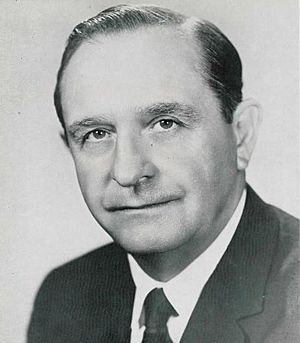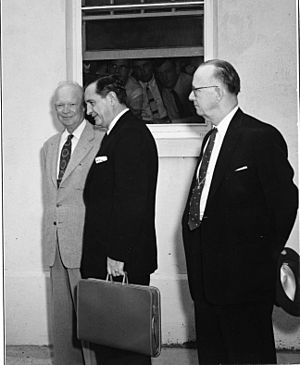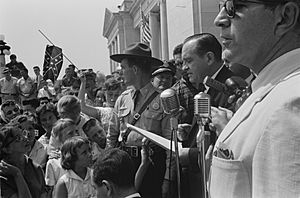Orval Faubus facts for kids
Quick facts for kids
Orval Faubus
|
|
|---|---|

Faubus in 1959
|
|
| 36th Governor of Arkansas | |
| In office January 11, 1955 – January 10, 1967 |
|
| Lieutenant | Nathan Green Gordon |
| Preceded by | Francis Cherry |
| Succeeded by | Winthrop Rockefeller |
| Personal details | |
| Born |
Orval Eugene Faubus
January 7, 1910 Madison County, Arkansas, U.S. |
| Died | December 14, 1994 (aged 84) Conway, Arkansas, U.S. |
| Resting place | Combs, Arkansas, U.S. |
| Political party | Democratic |
| Other political affiliations |
National States' Rights Party |
| Spouses |
Alta Haskins
(m. 1931; div. 1969)Elizabeth Westmoreland
(m. 1969; died 1983)Jan Wittenburg
(m. 1986) |
| Military service | |
| Allegiance | |
| Branch/service | United States Army |
| Years of service | 1942–1946 |
| Rank | Major |
| Unit | 320th Infantry Regiment |
| Battles/wars | |
Orval Eugene Faubus (born January 7, 1910 – died December 14, 1994) was an American politician. He was the 36th Governor of Arkansas, serving from 1955 to 1967. He was a member of the Democratic Party.
Faubus became famous in 1957 during the Little Rock Crisis. He used the Arkansas National Guard to stop nine African American students from attending Little Rock Central High School. This was against a U.S. Supreme Court decision that said schools should not be separated by race.
| Top - 0-9 A B C D E F G H I J K L M N O P Q R S T U V W X Y Z |
Early Life and First Steps in Politics
Orval Eugene Faubus was born in a small village called Combs in northwest Arkansas. His father, John Samuel Faubus, had socialist ideas. Orval even attended a socialist school called Commonwealth College for a while.
Faubus first tried to enter politics in 1936, running for a seat in the Arkansas House of Representatives. He lost that election. However, he later became the circuit clerk and recorder for Madison County, serving two terms.
During World War II, Faubus served in the United States Army. He wrote a book about his time in the military called In This Faraway Land. After the war, he became involved with leaders of Arkansas's Democratic Party. He worked for Governor Sid McMath as the director of the state's highway commission.
Becoming Governor
In 1954, Orval Faubus decided to run for governor. He challenged the current governor, Francis Cherry. During his campaign, some people tried to say that Faubus had "communist" ideas because he had attended Commonwealth College.
Winning the Democratic Primary
At first, Faubus denied attending the college for long. Later, he admitted he had been there for more than a year and had even been elected student body president. Despite the accusations, many voters did not like these kinds of attacks. Faubus won the Democratic nomination for governor.
The General Election
In the main election, Faubus ran against Pratt C. Remmel, the mayor of Little Rock. Faubus won by a large margin, getting 63% of the votes. He became governor as a liberal Democrat. He tried to balance social reforms and economic growth in Arkansas.
Governor of Arkansas: 1955–1967
Faubus served as governor for twelve years, winning six two-year terms. He was known for being good at talking to people one-on-one. He would shake hands with anyone who wanted to meet him.
The Little Rock Crisis
Faubus became known around the world during the Little Rock Crisis in 1957. This happened when he used the Arkansas National Guard to stop African American students from entering Little Rock Central High School. This was against a 1954 U.S. Supreme Court decision in the case of Brown v. Board of Education, which said that having separate schools for different races was unfair.
Many people believe that Faubus's actions in Little Rock were politically motivated. Some say he used the crisis to gain support and distract from other issues, like a tax increase.
Faubus's decision led to a disagreement with President Dwight D. Eisenhower. On September 5, 1957, President Eisenhower sent a message to Faubus, saying that the U.S. Constitution would be upheld. They met on September 14 to discuss the court order. Faubus said he wanted to follow the Constitution, despite his personal feelings.
However, on September 23, a large crowd formed at Central High School. The African American students had to be sent home for their safety. The mayor of Little Rock, Woodrow Wilson Mann, told President Eisenhower that the crowd's actions seemed planned.
In October 1957, President Eisenhower took control of the Arkansas National Guard and sent them away. He then sent soldiers from the 101st Airborne Division to Arkansas. These soldiers protected the black students and made sure the federal court order was followed. Later, the Arkansas National Guard took over the protection duties. In response, Faubus closed all Little Rock high schools for the 1958–1959 school year. This time is often called "The Lost Year."
In a 1985 interview, Faubus said he believed the crisis was caused by the federal government taking too much power. He felt he was acting in the best interest of his state.
Even though Faubus later lost popularity for supporting segregation, he was very admired by many Americans at the time. The Little Rock Crisis also inspired a song called "Fables of Faubus" by jazz artist Charles Mingus.
Faubus's Political Style

Faubus was elected governor six times, serving for twelve years. He kept a strong, common-person image. Over time, he became less confrontational with the federal government, especially during the presidencies of John F. Kennedy and Lyndon B. Johnson.
He won his elections by large margins. For example, in 1956, he won 80.7% of the votes. In 1958, he won 82.5%. In 1960, he won 69.2%.
In 1962, Faubus presented himself as a moderate on racial issues. He won the election that year without focusing on race. In 1964, he won 81% of the black vote, even though some black leaders still avoided him. He defeated Winthrop Rockefeller by a 57–43 percent margin.
1960 Presidential Election
During the 1960 presidential election, a group called the National States' Rights Party nominated Orval Faubus for President. However, Faubus did not actively campaign for this ticket. He received only a very small percentage of the national vote.
Later Life and Passing
Faubus decided not to run for a seventh term as governor in 1966. After he left office, Winthrop Rockefeller became the first Republican governor of Arkansas since the Reconstruction era.
In 1968, Faubus was considered as a possible running mate for presidential candidate George Wallace. However, Wallace chose someone else. In 1969, Faubus became the general manager of a theme park called Dogpatch USA in the Ozark Mountains. He joked that managing the park was similar to running the state government.
Faubus tried to become governor again in 1970, 1974, and 1986. But he lost in the Democratic primary elections to Dale Bumpers, David Pryor, and Bill Clinton, respectively.
Orval Faubus, who was a Southern Baptist, passed away from prostate cancer on December 14, 1994. He is buried in the Combs Cemetery in Combs, Arkansas.
Electoral History (Summary)
Orval Faubus ran for governor many times. Here's a simple look at some of his key elections:
- 1954: He won the Democratic primary runoff against Francis Cherry and then won the general election against Pratt Remmel.
- 1956, 1958, 1960, 1962, 1964: He won reelection as governor by large margins each time.
- 1970, 1974, 1986: After leaving office, he tried to become governor again but lost in the Democratic primary elections.


